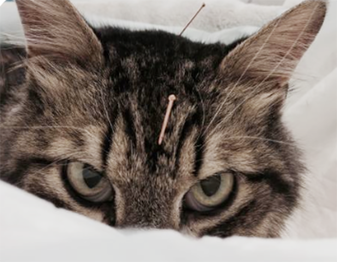
What precisely is acupuncture and how does it work?
According to the philosophy of traditional Chinese medicine, illness is caused by an imbalance of vital energies in the body. Acupuncture, an important aspect of this philosophy, focuses on restoring the body’s energy balance, thereby promoting healing.
Just as with people, acupuncture involves inserting very fine, filament-like needles into your affected cat’s body at points where the nerves and blood vessels converge. Called meridian sites, they’re believed to be energy channels responsible for transmitting energy throughout your cat’s body. Once these needles are properly placed, they enhance blood circulation, stimulate the nervous system and increase the release of anti-inflammatory and pain-relieving substances in order to reduce your cat’s discomfort.
Research has shown that acupuncture works through modulating the nerve pathways by interacting with nerve fibers in both the skin and its underlying tissues. This leads to the release of beneficial chemicals, including opioid-like neurochemicals, from the brain and spinal cord. Close to the needles themselves, substances that encourage blood flow to the area are released, interrupting pain signals and releasing the trigger points that cause painful spasms.
By increasing the tissues’ oxygenation, acupuncture reduces the amount of waste products produced and enables the body to remove them more efficiently. By relaxing the muscles, it relieves pain locally and generally. By stimulating the release of naturally occurring pain-relieving and anti-inflammatory substances, it may also decrease the dosage of any pain medication or anti-inflammatory drug your cat currently takes. And since it has no systemic side effects, it’s especially beneficial for a cat in poor health.
Among the assorted ailments aided by acupuncture are allergies and other forms of non-infectious inflammation, arthritis and vertebral disc pathology, gastrointestinal problems such as diarrhea, pain, paralysis, respiratory problems such as feline asthma, skin problems such as lick granuloma and various reproductive problems. (Acupuncture should not, however, be used as an alternative to drugs or surgery to treat severe or acute pain. Nor is it always appropriate for cats with cancer. As always, discuss this with the person you trust most: your vet.)
Before your first appointment with a veterinary acupuncturist, your vet will have already sent ahead your cat’s medical records outlining a history of her condition, all lab results, x-rays if applicable, and her present medical treatment(s). The acupuncturist will perform their own physical examination of your cat, discuss various treatment options, and explain precisely what happens during an acupuncture session.
Although some cats can’t or won’t tolerate acupuncture, most of them do. Despite a slight initial prick, it subsides when the needle is left in her skin. Experienced acupuncturists are especially sympathetic to a cat’s needs. Using as few needles as possible, inserting only a few at a time, and allowing your cat to rest and stretch out between needles will ensure that her treatment is both gentle and pleasant.
A session typically lasts between 20 and 30 minutes depending on the condition(s) being addressed, after which the acupuncturist will outline a treatment plan for your cat involving one to three sessions weekly for several weeks. While there are few side effects with acupuncture, your cat may be stiff, sore or seem tired after a session, but these symptoms usually resolve themselves within 24 to 48 hours.
As your cat improves, the number of sessions will be reduced accordingly. And although acupuncture’s beneficial effects are cumulative, the aim is to achieve and maintain the highest level of improvement with the fewest possible sessions. But if your cat can’t tolerate needles, consider trying low-level lasers and infrared light instead.









 RSS Feed
RSS Feed